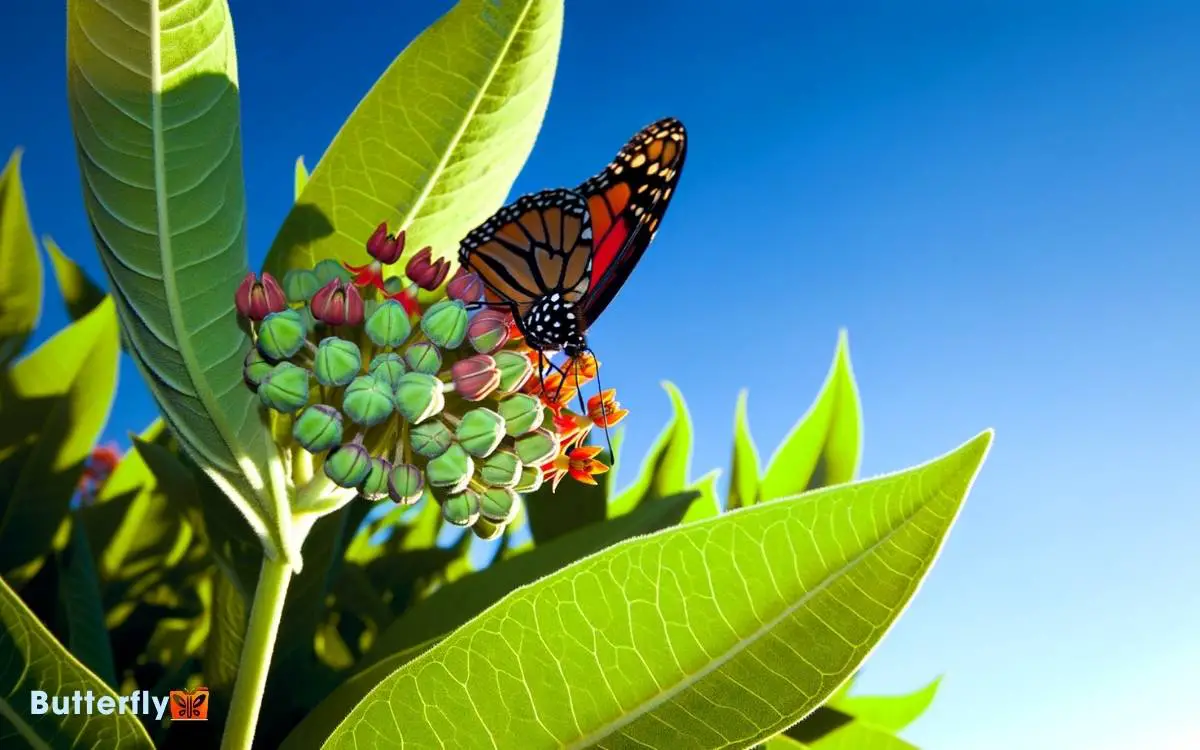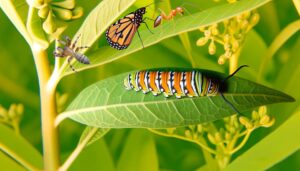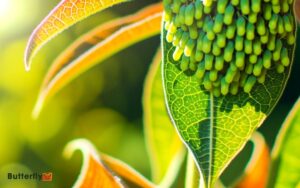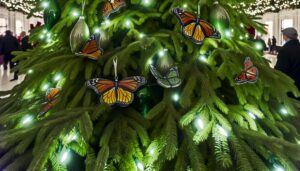Do Monarch Butterflies Eat Milkweed? Unveiling the Facts!
Monarch caterpillars (Danaus plexippus) rely exclusively on milkweed for nutrition, consuming up to 300 milligrams daily. This diet, rich in cardenolides, allows them to increase their body weight by 2,700 times during the larval stage.
Adult monarch butterflies primarily feed on the nectar of various flowering plants, including milkweed, which is crucial for their energy needs, especially during migration.
The availability and health of milkweed populations are indispensable for the monarchs’ life cycle and survival.
For more insights into their fascinating life processes, consider exploring their habitat requirements and the role of milkweed in their conservation.

Key Takeaways
Monarch Butterfly Overview
Monarch butterflies, known scientifically as *Danaus plexippus*, are renowned for their striking orange-and-black wings and their remarkable migratory patterns. You’ll find them traveling up to 3,000 miles from North America to central Mexico.
Data shows their wingspan ranges from 3.5 to 4 inches, making them easily identifiable. Monarchs have four stages in their life cycle: egg, larva (caterpillar), pupa (chrysalis), and adult butterfly.
They exhibit sexual dimorphism; males feature a distinct black spot on their hind wings, absent in females.
Monarchs are also known for their longevity compared to other butterflies, with some living up to eight months. Observational studies have shown that they rely heavily on milkweed plants for their reproductive success and survival.
Monarch Caterpillar Diet
Relying exclusively on milkweed, the monarch caterpillar’s diet is specialized to include chemical compounds called cardenolides, which provide both nutrition and protection from predators.
These compounds, also known as cardiac glycosides, accumulate in the caterpillar’s tissues, making them toxic to potential threats.
Studies show that monarch caterpillars can consume up to 300 milligrams of milkweed per day, depending on species and availability. This diet is essential for their growth, enabling them to gain up to 2,700 times their initial weight during the larval stage.
Data indicates that without milkweed, caterpillar survival rates plummet. Additionally, the cardenolides ingested during this stage remain in their bodies, offering continued protection throughout their lifecycle as butterflies.
Role of Milkweed
You’ll observe that milkweed is essential for monarch larvae, providing the sole food source required for their growth.
Data shows that without milkweed, monarch caterpillars experience high mortality rates and stunted development.
Additionally, these plants offer vital habitat, supporting the entire monarch life cycle.
Essential for Larvae
During their larval stage, monarch butterflies exhibit an exclusive dependence on milkweed plants for nourishment, which provides them with essential toxins that deter predators.
You’ll find that milkweed is critical for larval development due to its high concentration of cardenolides, which render the larvae toxic to most predators. This relationship is so specific that without milkweed, monarch larvae cannot survive.
Here’s a detailed breakdown:
| Stage | Primary Activity | Dependency on Milkweed |
|---|---|---|
| Egg | Hatching | Essential |
| Early Larvae | Initial Feeding | Exclusive |
| Mid Larvae | Growth and Molting | Exclusive |
| Late Larvae | Pre-pupal Development | Exclusive |
| Pupa | Transformation | Indirect (via larval stage) |
Understanding this dependency underscores the importance of conserving milkweed habitats for monarch survival.
Habitat and Growth
Milkweed plants not only serve as the exclusive food source for monarch larvae but also play an essential role in shaping their habitat and growth patterns. You’ll find that milkweed serves as both a nursery and a protective habitat.
Data indicates that female monarchs lay their eggs exclusively on milkweed plants. This guarantees that emerging larvae have immediate access to food. Additionally, milkweed’s toxic compounds, known as cardenolides, deter predators, offering a safer environment for larvae.
Observations show that monarch larvae grow more rapidly and exhibit higher survival rates when milkweed is abundant. The presence and health of milkweed populations directly influence monarch butterfly numbers, highlighting the plant’s critical role in their lifecycle and conservation.
Monarch Life Cycle
You’ll observe that Monarch butterflies undergo a fascinating life cycle, starting from an egg laid on milkweed leaves.
Within about four days, the egg hatches into a caterpillar, which consumes milkweed for about two weeks before forming a chrysalis.
After approximately 10-14 days, the butterfly emerges, completing its metamorphosis.
Egg to Caterpillar
Emerging from a tiny, translucent egg, the monarch caterpillar begins its life on the underside of a milkweed leaf. You’ll notice that within 3-5 days, the egg hatches, releasing a minuscule, black-headed larva.
This larva, or caterpillar, measures approximately 2-6 millimeters initially. It undergoes five growth stages, known as instars, over a span of 9-14 days.
During these stages, the caterpillar’s size increases greatly, reaching up to 45 millimeters. Each instar is characterized by a molt, shedding the old exoskeleton.
Detailed observations show the caterpillar’s feeding behavior is voracious, consuming large quantities of milkweed leaves. This consumption is important, as milkweed provides the necessary toxins that deter predators, ensuring the caterpillar’s survival through its larval stage.
Chrysalis to Butterfly
As the monarch caterpillar enters the pupal stage, it forms a chrysalis, which serves as a protective case where the metamorphosis into a butterfly occurs over approximately 10-14 days.
During this time, significant changes happen within the chrysalis:
- Enzymatic Breakdown: The caterpillar’s body releases enzymes to break down its tissues.
- Cellular Reorganization: Stem cells, known as imaginal discs, reorganize to form the future butterfly’s structures.
- Wing Development: Wings begin to develop, initially appearing as small, folded structures.
- Coloration and Hardening: The chrysalis gradually darkens and hardens as the butterfly nears emergence.
You’ll observe that, once the transformation is complete, the chrysalis becomes transparent, signaling the imminent emergence of the adult butterfly.
Adult Monarch Diet
Adult monarch butterflies primarily feed on the nectar of various flowering plants, including milkweed. This nectar provides essential sugars, which are important for their energy needs, especially during migration.
You’d observe that their proboscis, a specialized mouthpart, is adapted to access nectar from deep within flowers. Data shows adult monarchs prefer plants with abundant, easily accessible nectar.
Here’s a detailed look at some nectar sources:
| Plant Name | Nectar Availability |
|---|---|
| Milkweed | High |
| Lantana | Medium |
| Goldenrod | High |
Research indicates a strong preference for milkweed due to its high nectar yield. By consuming nectar, monarchs not only sustain themselves but also contribute to pollination, facilitating plant reproduction. Understanding their diet helps in conservation efforts.
Nectar-Rich Flowers
When evaluating nectar-rich flowers, it’s crucial to identify the species that provide the highest energy yield for monarch butterflies. These butterflies depend on nectar as a primary food source during migration and breeding.
Studies indicate that certain flowers offer superior energy benefits:
- Goldenrod (Solidago spp.): High sugar concentration, extended blooming period.
- Asters (Symphyotrichum spp.): Abundant nectar, late-season flowering.
- Purple Coneflower (Echinacea purpurea): Robust nectar supply, attracts diverse pollinators.
- Blazing Star (Liatris spp.): Tall spikes, dense flower clusters, rich in nectar.
Importance of Milkweed
You’ll find that milkweed plays an essential role in the monarchs’ lifespan, serving as their sole larval food source.
Observations indicate that without milkweed, monarchs can’t complete their breeding cycle, as it’s their primary habitat for laying eggs.
Conservation data shows that restoring milkweed populations is vital to counteract the decline in monarch butterfly numbers.
Monarchs’ Lifespan Dependence
Milkweed is essential for monarch butterflies’ lifespan, providing necessary nutrients that impact their survival and reproductive success. You should know that without milkweed, monarchs face significant challenges.
Key benefits of milkweed for monarchs include:
- Nutritional Support: Milkweed contains cardenolides, which are vital for monarch caterpillars’ growth and development.
- Defense Mechanism: These cardenolides make monarchs toxic to predators, offering a protective advantage.
- Reproduction: Female monarchs lay eggs exclusively on milkweed, ensuring larvae have immediate access to food upon hatching.
- Lifecycle Synchronization: Milkweed availability directly influences the timing and success of monarch migrations.
Habitat and Breeding Ground
A diverse and abundant milkweed habitat is essential for monarch butterflies’ breeding success, as it provides the necessary resources needed for their lifecycle stages.
Monarchs lay their eggs exclusively on milkweed plants. Upon hatching, larvae consume milkweed leaves, which contain toxic compounds that deter predators.
Research indicates that areas with high milkweed density correlate with increased monarch population resilience.
Detailed observations have shown that larvae feeding on milkweed exhibit better growth rates and survival chances. Additionally, adult butterflies rely on milkweed flowers for nectar, crucial for their energy needs during migration.
Data-driven studies emphasize the direct link between milkweed availability and monarch breeding success, highlighting the plant’s critical role in supporting monarch populations.
Conservation and Restoration Efforts
Conservationists emphasize the importance of restoring milkweed habitats to bolster monarch butterfly populations. They cite data that demonstrates increased survival rates in areas with dense milkweed growth.
Studies show that milkweed availability is essential for monarch larvae, as it provides essential nutrients and protection from predators.
To support these efforts, you can focus on the following:
- Plant native milkweed species: Choose species that are native to your region to maintain proper ecological balance.
- Avoid pesticides: Pesticides can be harmful to both milkweed and monarchs.
- Create milkweed corridors: Establish continuous habitats to facilitate monarch migration.
- Participate in citizen science: Contribute to monitoring efforts and data collection.
These actions can have a significant impact on the conservation of monarch butterflies.
Conservation Efforts
Efforts to conserve monarch butterflies have increasingly focused on restoring native milkweed habitats, supported by data showing a 90% decline in their population over the past two decades.
You can contribute by planting milkweed species native to your region, as these plants are vital for monarch reproduction. Studies indicate that urbanization and agricultural practices have drastically reduced milkweed availability.
By integrating milkweed into gardens, parks, and roadside areas, you help create essential breeding grounds. Data from citizen science projects reveal that even small-scale plantings can greatly benefit monarch populations.
Additionally, advocating for pesticide regulation and participating in habitat restoration programs amplifies conservation impacts. Your actions directly influence the survival of this iconic species.
Are Monarch Butterflies in Australia Known to Eat Milkweed?
Yes, monarch butterflies in australia are known to eat milkweed. Despite being a different species from their North American counterparts, Australian monarch butterflies also rely on milkweed as their main source of food. This specific type of plant provides essential nutrients and toxins that help protect the butterflies from predators.
Habitat Requirements
Understanding the specific habitat requirements for monarch butterflies is crucial to guaranteeing their successful reproduction and survival.
You need to focus on four primary components:
- Milkweed Availability: Monarchs rely on milkweed as their sole larval food source. Ensure there’s abundant milkweed in their habitat.
- Nectar Sources: Adult monarchs need diverse flowering plants for nectar. Include species that bloom at different times.
- Climate Conditions: Monarchs prefer temperate climates. They need suitable temperatures for breeding and migration.
- Safe Habitats: Reduce pesticide use and provide safe areas away from urban development and agricultural fields.
Supporting Monarchs
To support monarch butterflies effectively, integrate a mix of native milkweed species and nectar-rich flowering plants into your local ecosystem.
Monarchs rely on milkweed for laying eggs and larval food, while adults need diverse nectar sources for sustenance during migration.
Research indicates planting Asclepias syriaca, Asclepias incarnata, and Asclepias tuberosa boosts local monarch populations. Additionally, incorporate nectar plants like Liatris spicata and Echinacea purpurea.
Data from the Xerces Society shows that gardens with 10+ milkweed plants and varied nectar flora increase monarch sightings by 50%. Regular monitoring and adaptive management of these habitats maintain their support year-round.
Conclusion
You can make a significant impact on monarch conservation by planting milkweed.
Did you know that a single female monarch can lay up to 500 eggs in her lifetime? This statistic highlights just how much milkweed is needed for their survival.
By creating a milkweed-rich habitat, you’re directly supporting the monarch population.
Remember, every milkweed plant you grow contributes to their life cycle and helps sustain this incredible species.
Your actions matter in conserving these beautiful butterflies.







I don’t think the title of your article matches the content lol. Just kidding, mainly because I had some doubts after reading the article. https://www.binance.com/hu/register?ref=FIHEGIZ8
Thanks for sharing. I read many of your blog posts, cool, your blog is very good.
Thank you for your sharing. I am worried that I lack creative ideas. It is your article that makes me full of hope. Thank you. But, I have a question, can you help me?
Thanks for sharing. I read many of your blog posts, cool, your blog is very good.
Your article helped me a lot, is there any more related content? Thanks!
Can you be more specific about the content of your article? After reading it, I still have some doubts. Hope you can help me.
Can you be more specific about the content of your article? After reading it, I still have some doubts. Hope you can help me.
Thank you for your sharing. I am worried that I lack creative ideas. It is your article that makes me full of hope. Thank you. But, I have a question, can you help me?
Thank you for your sharing. I am worried that I lack creative ideas. It is your article that makes me full of hope. Thank you. But, I have a question, can you help me?
Your article helped me a lot, is there any more related content? Thanks!
Your point of view caught my eye and was very interesting. Thanks. I have a question for you.
Can you be more specific about the content of your article? After reading it, I still have some doubts. Hope you can help me.